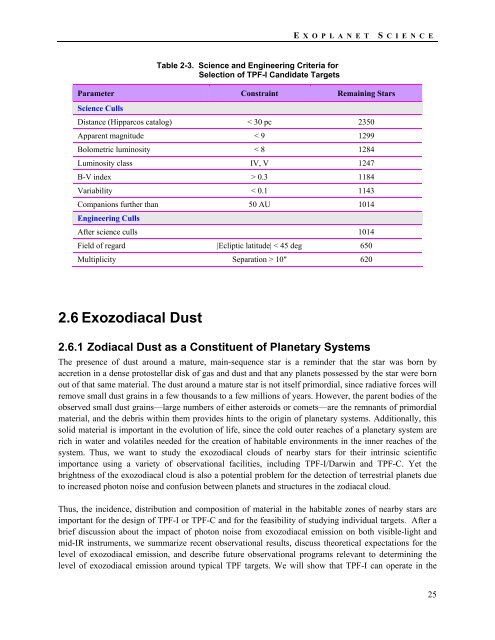TPF-I SWG Report - Exoplanet Exploration Program - NASA
TPF-I SWG Report - Exoplanet Exploration Program - NASA
TPF-I SWG Report - Exoplanet Exploration Program - NASA
You also want an ePaper? Increase the reach of your titles
YUMPU automatically turns print PDFs into web optimized ePapers that Google loves.
E X O P L A N E T S CIENCE<br />
Table 2-3. Science and Engineering Criteria for<br />
Selection of <strong>TPF</strong>-I Candidate Targets<br />
Parameter Constraint Remaining Stars<br />
Science Culls<br />
Distance (Hipparcos catalog) < 30 pc 2350<br />
Apparent magnitude < 9 1299<br />
Bolometric luminosity < 8 1284<br />
Luminosity class IV, V 1247<br />
B-V index > 0.3 1184<br />
Variability < 0.1 1143<br />
Companions further than 50 AU 1014<br />
Engineering Culls<br />
After science culls 1014<br />
Field of regard |Ecliptic latitude| < 45 deg 650<br />
Multiplicity Separation > 10" 620<br />
2.6 Exozodiacal Dust<br />
2.6.1 Zodiacal Dust as a Constituent of Planetary Systems<br />
The presence of dust around a mature, main-sequence star is a reminder that the star was born by<br />
accretion in a dense protostellar disk of gas and dust and that any planets possessed by the star were born<br />
out of that same material. The dust around a mature star is not itself primordial, since radiative forces will<br />
remove small dust grains in a few thousands to a few millions of years. However, the parent bodies of the<br />
observed small dust grains—large numbers of either asteroids or comets—are the remnants of primordial<br />
material, and the debris within them provides hints to the origin of planetary systems. Additionally, this<br />
solid material is important in the evolution of life, since the cold outer reaches of a planetary system are<br />
rich in water and volatiles needed for the creation of habitable environments in the inner reaches of the<br />
system. Thus, we want to study the exozodiacal clouds of nearby stars for their intrinsic scientific<br />
importance using a variety of observational facilities, including <strong>TPF</strong>-I/Darwin and <strong>TPF</strong>-C. Yet the<br />
brightness of the exozodiacal cloud is also a potential problem for the detection of terrestrial planets due<br />
to increased photon noise and confusion between planets and structures in the zodiacal cloud.<br />
Thus, the incidence, distribution and composition of material in the habitable zones of nearby stars are<br />
important for the design of <strong>TPF</strong>-I or <strong>TPF</strong>-C and for the feasibility of studying individual targets. After a<br />
brief discussion about the impact of photon noise from exozodiacal emission on both visible-light and<br />
mid-IR instruments, we summarize recent observational results, discuss theoretical expectations for the<br />
level of exozodiacal emission, and describe future observational programs relevant to determining the<br />
level of exozodiacal emission around typical <strong>TPF</strong> targets. We will show that <strong>TPF</strong>-I can operate in the<br />
25
















